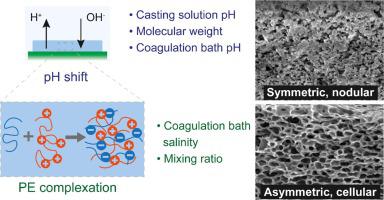当前位置:
X-MOL 学术
›
Eur. Polym. J.
›
论文详情
Our official English website, www.x-mol.net, welcomes your feedback! (Note: you will need to create a separate account there.)
Weak polyanion and strong polycation complex based membranes: linking aqueous phase separation to traditional membrane fabrication
European Polymer Journal ( IF 6 ) Pub Date : 2020-10-01 , DOI: 10.1016/j.eurpolymj.2020.110015 E.N. Durmaz , Joshua D. Willott , Arooj Fatima , Wiebe M. de Vos
European Polymer Journal ( IF 6 ) Pub Date : 2020-10-01 , DOI: 10.1016/j.eurpolymj.2020.110015 E.N. Durmaz , Joshua D. Willott , Arooj Fatima , Wiebe M. de Vos

|
Abstract In recent work, Aqueous Phase Separation (APS) based on pH change induced polyelectrolyte complexation has shown great potential for the preparation of sustainable polymeric membranes with tunable structures. Unfortunately, thus far this has only been possible with a single polyelectrolyte combination. In this work, we demonstrate that this APS approach extends beyond a single system by preparing sustainable membranes from polyelectrolyte complexes (PECs) of the weak polyanion poly(acrylic acid) (PAA) and the strong polycation poly(diallyldimethylammonium chloride) (PDADMAC). PE solutions are mixed in an acidic medium where PAA is uncharged, and then this mixture is cast and immersed in a coagulation bath at a pH where PAA becomes charged and able to form a PEC with the oppositely charged PDADMAC. Since this process includes both phase separation and PE complexation, it is expected that membrane structure and performance is influenced by a combination of many factors. Casting solution pH, PAA molecular weight, and coagulation bath pH all directly affect the phase separation behavior of PAA/PDADMAC complexes in ways similar to conventional nonsolvent induced phase separation (NIPS). In addition, coagulation bath salinity and PE mixing ratio influence the complexation behavior. Through tuning of all these parameters it is possible to create a wide variety of membrane structures, ranging from nodular symmetrically porous membranes, to asymmetric membranes with cellular pores and in some cases dense top layers. The nodular membranes show good performance as microfiltration membranes with excellent oil retention (>95% for 3–4 µm droplets) and good water permeances. However for the cellular membranes, filtration led to collapse of the porous structure, emphasizing the importance of PE selection for membrane applications.
中文翻译:

基于弱聚阴离子和强聚阳离子复合物的膜:将水相分离与传统膜制造联系起来
摘要 在最近的工作中,基于 pH 变化诱导聚电解质络合的水相分离 (APS) 在制备具有可调结构的可持续聚合物膜方面显示出巨大的潜力。不幸的是,到目前为止,这只能通过单一的聚电解质组合来实现。在这项工作中,我们证明了这种 APS 方法通过从弱聚阴离子聚(丙烯酸)(PAA)和强聚阳离子聚(二烯丙基二甲基氯化铵)(PDADMAC)的聚电解质复合物(PEC)制备可持续膜而扩展到单个系统之外。PE 溶液在 PAA 不带电荷的酸性介质中混合,然后将该混合物浇铸并浸入凝固浴中,其 pH 值使 PAA 带电并能够与带相反电荷的 PDMAC 形成 PEC。由于该过程包括相分离和 PE 络合,因此预计膜结构和性能受多种因素的综合影响。浇铸溶液 pH、PAA 分子量和凝固浴 pH 都以类似于传统非溶剂诱导相分离 (NIPS) 的方式直接影响 PAA/PDADMAC 复合物的相分离行为。此外,凝固浴盐度和PE混合比影响络合行为。通过调整所有这些参数,可以创建各种各样的膜结构,从结节对称多孔膜到具有蜂窝孔的不对称膜,在某些情况下还有致密的顶层。球状膜作为微滤膜表现出良好的性能,具有出色的保油性 (> 3–4 µm 液滴为 95%)和良好的水渗透性。然而,对于细胞膜,过滤导致多孔结构的坍塌,强调了 PE 选择对于膜应用的重要性。
更新日期:2020-10-01
中文翻译:

基于弱聚阴离子和强聚阳离子复合物的膜:将水相分离与传统膜制造联系起来
摘要 在最近的工作中,基于 pH 变化诱导聚电解质络合的水相分离 (APS) 在制备具有可调结构的可持续聚合物膜方面显示出巨大的潜力。不幸的是,到目前为止,这只能通过单一的聚电解质组合来实现。在这项工作中,我们证明了这种 APS 方法通过从弱聚阴离子聚(丙烯酸)(PAA)和强聚阳离子聚(二烯丙基二甲基氯化铵)(PDADMAC)的聚电解质复合物(PEC)制备可持续膜而扩展到单个系统之外。PE 溶液在 PAA 不带电荷的酸性介质中混合,然后将该混合物浇铸并浸入凝固浴中,其 pH 值使 PAA 带电并能够与带相反电荷的 PDMAC 形成 PEC。由于该过程包括相分离和 PE 络合,因此预计膜结构和性能受多种因素的综合影响。浇铸溶液 pH、PAA 分子量和凝固浴 pH 都以类似于传统非溶剂诱导相分离 (NIPS) 的方式直接影响 PAA/PDADMAC 复合物的相分离行为。此外,凝固浴盐度和PE混合比影响络合行为。通过调整所有这些参数,可以创建各种各样的膜结构,从结节对称多孔膜到具有蜂窝孔的不对称膜,在某些情况下还有致密的顶层。球状膜作为微滤膜表现出良好的性能,具有出色的保油性 (> 3–4 µm 液滴为 95%)和良好的水渗透性。然而,对于细胞膜,过滤导致多孔结构的坍塌,强调了 PE 选择对于膜应用的重要性。


























 京公网安备 11010802027423号
京公网安备 11010802027423号